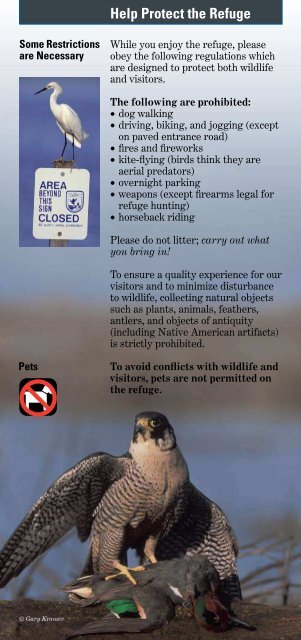Humboldt Bay - U.S. Fish and Wildlife Service
Humboldt Bay - U.S. Fish and Wildlife Service
Humboldt Bay - U.S. Fish and Wildlife Service
Create successful ePaper yourself
Turn your PDF publications into a flip-book with our unique Google optimized e-Paper software.
Some Restrictions<br />
are Necessary<br />
Pets<br />
© Gary Kramer<br />
Help Protect the Refuge<br />
While you enjoy the refuge, please<br />
obey the following regulations which<br />
are designed to protect both wildlife<br />
<strong>and</strong> visitors.<br />
The following are prohibited:<br />
• dog walking<br />
• driving, biking, <strong>and</strong> jogging (except<br />
on paved entrance road)<br />
• fres <strong>and</strong> freworks<br />
• kite-fying (birds think they are<br />
aerial predators)<br />
• overnight parking<br />
• weapons (except frearms legal for<br />
refuge hunting)<br />
• horseback riding<br />
Please do not litter; carry out what<br />
you bring in!<br />
To ensure a quality experience for our<br />
visitors <strong>and</strong> to minimize disturbance<br />
to wildlife, collecting natural objects<br />
such as plants, animals, feathers,<br />
antlers, <strong>and</strong> objects of antiquity<br />
(including Native American artifacts)<br />
is strictly prohibited.<br />
To avoid conficts with wildlife <strong>and</strong><br />
visitors, pets are not permitted on<br />
the refuge.<br />
Why are hunting<br />
<strong>and</strong> fshing<br />
allowed on this<br />
National<br />
<strong>Wildlife</strong> Refuge,<br />
but not walking<br />
my dog, jogging,<br />
or biking?<br />
Why is there<br />
haying <strong>and</strong>/or<br />
grazing on the<br />
refuge?<br />
Aleutian<br />
cackling geese<br />
© Michael Peters<br />
Frequently Asked Questions<br />
The National <strong>Wildlife</strong> Refuge System<br />
was established in 1903 to “preserve<br />
a national network of l<strong>and</strong>s <strong>and</strong><br />
waters for the conservation <strong>and</strong><br />
management of fsh, wildlife, <strong>and</strong><br />
plant resources of the United States<br />
for the beneft of present <strong>and</strong> future<br />
generations.” This includes the<br />
following six priority public uses:<br />
wildlife observation, photography,<br />
interpretation, environmental<br />
education, hunting, <strong>and</strong> fshing. These<br />
pursuits are all wildlife dependent,<br />
while other activities such as jogging,<br />
biking <strong>and</strong> dog walking can be done at<br />
many other places.<br />
In the early 1900s most of the<br />
saltmarsh around the bay was diked<br />
off to create pasture. When kept short<br />
<strong>and</strong> nutritious, these grassl<strong>and</strong>s are<br />
used each winter <strong>and</strong> spring by many<br />
species of shorebirds, tundra swans,<br />
wigeon, <strong>and</strong> especially thous<strong>and</strong>s of<br />
Aleutian cackling geese. This once<br />
endangered population of geese has<br />
recovered from less than 800 in 1974<br />
to more than 100,000 in 2006. These<br />
geese are now having an increasing<br />
economic impact on local ranchers as<br />
signifcant numbers of geese graze<br />
on private l<strong>and</strong>s. To maintain optimal<br />
conditions for wildlife, management<br />
techniques include a combination of<br />
mowing, haying, <strong>and</strong> grazing.

















